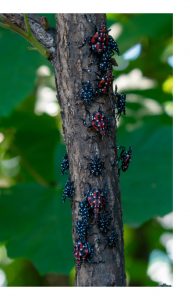Protecting Your Trees from Spotted Lanternflies in Southeastern PA
July 20, 2021When mother nature’s checks and balances aren’t in place, invasive species can run rampant. That’s what we’ve experienced over the past several years with the spotted lanternfly – an invasive planthopper with few natural predators that’s taken a liking to many of the trees here in Southeastern Pennsylvania.
Every spring, we continue to see the sprawl of the spotted lanternfly expand. This spring, we expect the insects to continue to move south and west while taking hold in Southeastern Pennsylvania even more than they did last year.
Understanding the Threat Spotted Lanternflies Cause to Your Trees
The spotted lanternfly enjoys feeding on many of the trees found in Southeastern PA. They feed on over 70 types of plants and especially enjoy maple, black walnut, birch, willow, and other trees as well as grapevines and hops.
The damage these pests cause our trees is due to more than their feeding habits than anything else. They act as stressors to the trees that, when combined with natural stressors like disease and weather, can quickly impact tree health.
Squashing the lanternflies you find around your yard is, unfortunately, not enough to reduce their population. Treating your trees at the right time of year at the right point in their life cycle is the best means of control. By learning more about the life cycle of the spotted lanternfly you’ll recognize the right time of year to treat your trees.
The Spotted Lanternfly Life Cycle Consists of 5 Phases
Spotted lanternflies go through dramatic transitions in body size and color from the early spring through the fall. Their life cycle is broken down into 5 phases.
The first phase is the egg mass. Egg masses start to show on trees in April and usually start to hatch between the end of April and as late as June depending on the temperature. Each egg mass is the home of up to as many as 40 eggs.
Once the eggs hatch, the spotted lanternflies go through an early nymph stage and then a late nymph stage. Early nymphs are black with white dots. In our region, we’ll start seeing early nymphs as early as late April through July.
By the time they’ve reached the late nymph stage, spotted lanternflies have red bodies with white spots and black legs. They’ll reach this stage around July in our region and stay this way until September.
The fourth stage of the spotted lanternfly is the first adult stage. Here they grow spotted wings that stay closed. Depending on the temperature, adults can emerge as early as July but are more common in early fall.
Finally, the spotted lanternfly reaches its second adult stage in the fall. Its wings open and it begins to fly. Now, it’s out to find a tree and create a nest so it can lay its eggs before the cold weather hits.

Spotted Lanternflies Love to Hitchhike
One of the biggest reasons that spotted lanternflies are so hard to control is that they love to hitchhike. They’ll find their way onto cars, campers and any other vehicle they can. Then, when you travel outside of the area, the lanternflies hop a ride to new regions of the country. This is largely how they’ve migrated down the east coast, moving further south and west every season.
For this reason, a good portion of Pennsylvania, including Lancaster and the surrounding counties, are spotted lanternfly quarantine zones. If you plan to drive outside of the county, check your car for spotted lanternflies before you go. Look under the hood, under each side of the vehicle, and around the tires.
Spotted Lanternflies Are Causing Harm to Pennsylvania’s Economy, Too
Trees in Pennsylvania aren’t the only ones in danger as the spotted lanternfly spreads across our state. The trees and plants that spotted lanternflies enjoy most are all tied to major industries and exports that our state relies on for revenue.
There’s a very real possibility that the USDA will begin to limit exports out of the state to reduce the risk of the spotted lanternfly spreading into other regions of the country.
Penn State University economists carried out a study of the economic impact of the spotted lanternfly in Pennsylvania and found that the invasive insects could potentially drain the state’s economy by at least $324 million annually if not contained.
What Should You Do if You See Spotted Lanternflies on Your Property This Summer?
 If you begin a search for egg masses in April, you can strike early and remove them from your trees. The best way to do this is to scrape the egg mass into a paper towel soaked in rubbing alcohol and then dispose of them.
If you begin a search for egg masses in April, you can strike early and remove them from your trees. The best way to do this is to scrape the egg mass into a paper towel soaked in rubbing alcohol and then dispose of them.
Once the eggs hatch and the young black and white nymphs appear, try to resist the temptation to immediately start treating your trees. Why?
Our plant care specialists recommend waiting to treat the lanternflies until later in the summer during their adult phases. We recommend targeted treatments in the summer rather than mass treatments in the spring for two reasons.
- Early Spring Mass Treatments Only Harm the Good Bugs. If you do a mass treatment across your yard to prevent spotted lanternflies from setting up camp in your trees, you’ll do more harm than good. That’s because spotted lanternflies fly from tree to tree, moving around the region they’re in. If you spray your trees in the spring, you’ll harm the good insects only to have new, healthy spotted lanternflies fly in days or weeks later.
- Summer Treatments Are Targeted, Going After the Adults as they Move Back into the Trees. By waiting to treat a spotted lanternfly infestation until at least August, our plant care specialists can take a much more targeted approach. A systemic treatment targets female adults as they are feeding on the host tree before they lay their eggs. You’re more likely to kill the lanternflies this way, and less likely to damage your other trees, shrubs and the good insects around your yard.
Treat Your Property to Keep Spotted Lanternflies from Taking Over
If your property is home to the trees spotted lanternflies love most, treating your property in late summer can help. We’ll come out and put together a spotted lanternfly treatment plan to help suppress spotted lanternflies on your property and support the health of the rest of your trees and plants. Contact us to schedule an appointment.

